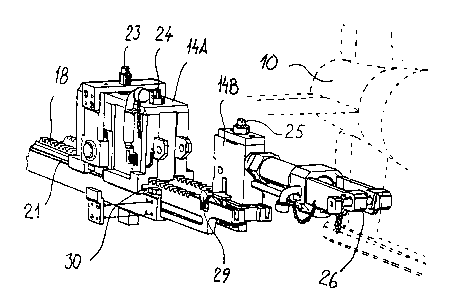Une partie des informations de ce site Web a été fournie par des sources externes. Le gouvernement du Canada n'assume aucune responsabilité concernant la précision, l'actualité ou la fiabilité des informations fournies par les sources externes. Les utilisateurs qui désirent employer cette information devraient consulter directement la source des informations. Le contenu fourni par les sources externes n'est pas assujetti aux exigences sur les langues officielles, la protection des renseignements personnels et l'accessibilité.
L'apparition de différences dans le texte et l'image des Revendications et de l'Abrégé dépend du moment auquel le document est publié. Les textes des Revendications et de l'Abrégé sont affichés :
| (12) Demande de brevet: | (11) CA 2066668 |
|---|---|
| (54) Titre français: | METHODE ET DISPOSITIF POUR CHARGER ET DEPLACER DES TORPILLES |
| (54) Titre anglais: | METHOD AND DEVICE FOR MOVING TORPEDOS |
| Statut: | Réputée abandonnée et au-delà du délai pour le rétablissement - en attente de la réponse à l’avis de communication rejetée |
| (51) Classification internationale des brevets (CIB): |
|
|---|---|
| (72) Inventeurs : |
|
| (73) Titulaires : |
|
| (71) Demandeurs : |
|
| (74) Agent: | R. WILLIAM WRAY & ASSOCIATES |
| (74) Co-agent: | |
| (45) Délivré: | |
| (86) Date de dépôt PCT: | 1990-09-26 |
| (87) Mise à la disponibilité du public: | 1991-03-27 |
| Licence disponible: | S.O. |
| Cédé au domaine public: | S.O. |
| (25) Langue des documents déposés: | Anglais |
| Traité de coopération en matière de brevets (PCT): | Oui |
|---|---|
| (86) Numéro de la demande PCT: | PCT/SE1990/000615 |
| (87) Numéro de publication internationale PCT: | SE1990000615 |
| (85) Entrée nationale: | 1992-03-25 |
| (30) Données de priorité de la demande: | ||||||
|---|---|---|---|---|---|---|
|
2066668 9104905 PCTABS00003
The inventiion relates to a method and a device for moving a
torpedo (10). A loading means (14) releasably connected to said
torpedo engages a movable driven carrier (16), which is moved towards
a torpedo tube (11). A part of said loading means (14) connected
to said torpedo is released from engaging said carrier (16) and
engages a rod (18) projectable from a guideway, said carrier again
being moved towards said tropedo tube. The movement of said
carrier is conveyed to a linear movement of said rod (18), which is
projected from said guideway.
Note : Les revendications sont présentées dans la langue officielle dans laquelle elles ont été soumises.
Note : Les descriptions sont présentées dans la langue officielle dans laquelle elles ont été soumises.

2024-08-01 : Dans le cadre de la transition vers les Brevets de nouvelle génération (BNG), la base de données sur les brevets canadiens (BDBC) contient désormais un Historique d'événement plus détaillé, qui reproduit le Journal des événements de notre nouvelle solution interne.
Veuillez noter que les événements débutant par « Inactive : » se réfèrent à des événements qui ne sont plus utilisés dans notre nouvelle solution interne.
Pour une meilleure compréhension de l'état de la demande ou brevet qui figure sur cette page, la rubrique Mise en garde , et les descriptions de Brevet , Historique d'événement , Taxes périodiques et Historique des paiements devraient être consultées.
| Description | Date |
|---|---|
| Inactive : CIB de MCD | 2006-03-11 |
| Le délai pour l'annulation est expiré | 1994-03-26 |
| Demande non rétablie avant l'échéance | 1994-03-26 |
| Réputée abandonnée - omission de répondre à un avis sur les taxes pour le maintien en état | 1993-09-27 |
| Inactive : Demande ad hoc documentée | 1993-09-27 |
| Demande publiée (accessible au public) | 1991-03-27 |
| Date d'abandonnement | Raison | Date de rétablissement |
|---|---|---|
| 1993-09-27 |
Les titulaires actuels et antérieures au dossier sont affichés en ordre alphabétique.
| Titulaires actuels au dossier |
|---|
| KOCKUMS AB |
| Titulaires antérieures au dossier |
|---|
| IVAN BOSTROM |